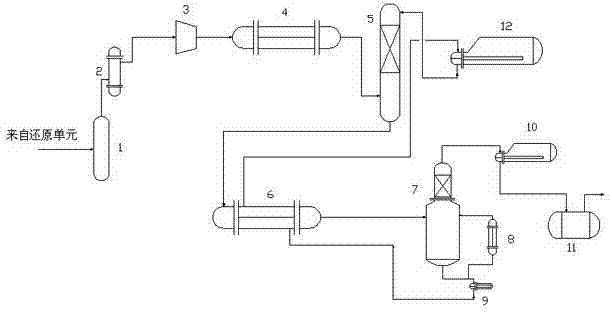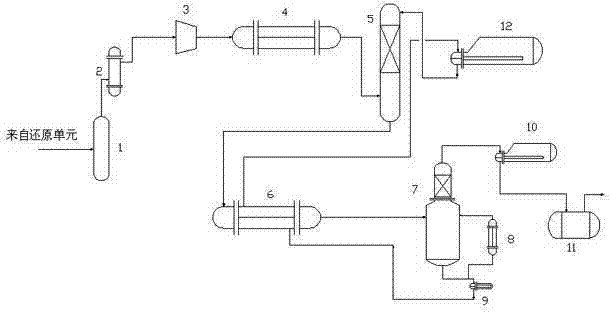Method for promoting purity of chlorine hydride recycled by reduction unit of polysilicon tail gas separating system
A separation system, hydrogen chloride technology, applied in separation methods, chlorine/hydrogen chloride, chemical instruments and methods, etc., can solve the problems of waste, environmental pollution, low purity of recovered hydrogen chloride, etc., and achieve the effect of improving the purity
- Summary
- Abstract
- Description
- Claims
- Application Information
AI Technical Summary
Problems solved by technology
Method used
Image
Examples
Embodiment 1
[0024] A method for improving the purity of hydrogen chloride recovered from a reduction unit of a polysilicon tail gas separation system, comprising the following steps:
[0025] (1) The hydrogen chloride gas from the reduction unit of the polysilicon tail gas dry separation system first enters the separator 1 of the hydrogenation unit of the separation system, and mixes with the gas (hydrogen chloride and hydrogen) of the hydrogenation unit itself of the polysilicon tail gas dry separation system. The gas includes hydrogen, hydrogen chloride, dichlorodihydrosilane, trichlorosilane, and silicon tetrachloride. The mixed gas is heat-exchanged through the gas-gas heat exchanger 2, and the mixed gas is exchanged through the first gas-gas heat exchanger 2. The temperature is -4°C and the pressure is 0.45MpaG. The mixed gas after heat exchange is pressurized by the compressor 3 to increase the pressure of the mixed gas. After the mixed gas is compressed to a temperature of 40°C and ...
Embodiment 2
[0029] A method for improving the purity of hydrogen chloride recovered from a reduction unit of a polysilicon tail gas separation system, comprising the following steps:
[0030] (1) The hydrogen chloride gas from the reduction unit of the polysilicon tail gas dry separation system first enters the separator 1 of the hydrogenation unit of the separation system, and mixes with the gas (hydrogen chloride and hydrogen) of the hydrogenation unit itself of the polysilicon tail gas dry separation system. The gas includes hydrogen, hydrogen chloride, dichlorodihydrosilane, trichlorosilane, and silicon tetrachloride. The mixed gas is heat-exchanged through the gas-gas heat exchanger 2, and the mixed gas is exchanged through the first gas-gas heat exchanger 2. The temperature is 10°C and the pressure is 0.45MpaG. After the heat exchange, the mixed gas is pressurized by compressor 3 to increase the pressure of the mixed gas. After the mixed gas is compressed to a temperature of 40°C and...
Embodiment 3
[0034] A method for improving the purity of hydrogen chloride recovered from a reduction unit of a polysilicon tail gas separation system, comprising the following steps:
[0035] (1) The hydrogen chloride gas from the reduction unit of the polysilicon tail gas dry separation system first enters the separator 1 of the hydrogenation unit of the separation system, and mixes with the gas (hydrogen chloride and hydrogen) of the hydrogenation unit itself of the polysilicon tail gas dry separation system. The gas includes hydrogen, hydrogen chloride, dichlorodihydrosilane, trichlorosilane, and silicon tetrachloride. The mixed gas is heat-exchanged through the gas-gas heat exchanger 2, and the mixed gas is exchanged through the first gas-gas heat exchanger 2. The temperature is 5°C and the pressure is 0.45MpaG. After the heat exchange, the mixed gas is pressurized by the compressor 3 to increase the pressure of the mixed gas. After the mixed gas is compressed to a temperature of 40°C an...
PUM
 Login to View More
Login to View More Abstract
Description
Claims
Application Information
 Login to View More
Login to View More - R&D
- Intellectual Property
- Life Sciences
- Materials
- Tech Scout
- Unparalleled Data Quality
- Higher Quality Content
- 60% Fewer Hallucinations
Browse by: Latest US Patents, China's latest patents, Technical Efficacy Thesaurus, Application Domain, Technology Topic, Popular Technical Reports.
© 2025 PatSnap. All rights reserved.Legal|Privacy policy|Modern Slavery Act Transparency Statement|Sitemap|About US| Contact US: help@patsnap.com


